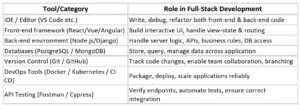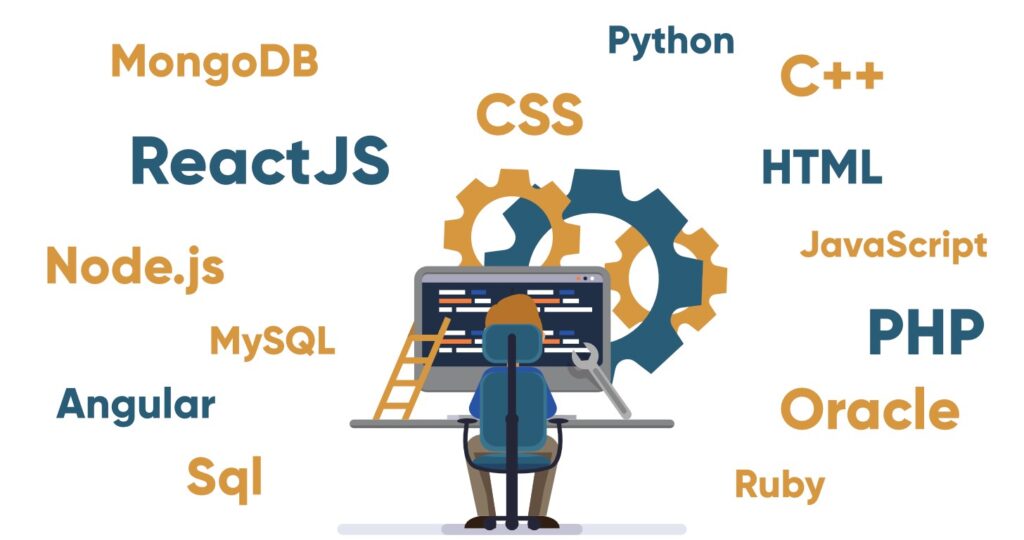Introduction
Creating whole web applications, full stack developers operate both client and server sides. They build, test, and deploy systems effectively using a broad array of tools. These tools assist database administration, coding, version control, and cloud distribution. Enrolling in the Best Full Stack Developer Course will enable you to master both front-end and back-end technologies for producing dynamic web applications, therefore improving code quality, application performance, and productivity.
Below are several often used and suggested tools for Full Stack Developers.
Let’s explore each one:
Integrated Development Environment (IDE) and Code Editor
The core of a complete-stack developer’s work is an IDE or code editor. Lightweight construction, strong plugin ecosystem, and integrated Git capability help tools like Visual Studio Code (VS Code) prevail. VS Code enables one-place front-end and back-end code editing. Though VS Code is somewhat well balanced, some developers prefer more specialized editors (Neovim for customizability and speed, among others). An IDE that provides extensibility, syntax highlighting, debugging, and version control increases output.
Front-end Frameworks and Libraries
Modern web applications on the client-side require adaptable interfaces, rapid updates, and recyclable elements. Leading this area are React (JavaScript) libraries as they let you generate interactive UIs using a virtual DOM and component-based design. Tool-lists also include alternate frameworks such Vue.js and Angular. One front-end framework should be selected by a full-stack developer, then mastered. It helps to streamline component reuse across view, routing, and state-management.
Back-end Environments and Server Frameworks
You want on the server side a setup able to manage database access, APIs, front-end integration, and processing logic. For JavaScript in full-stack, Node.js stands apart in that it enables non-blocking I/O, manages many connections, and allows you to utilize JavaScript on both the front-end and the back-end. Lowering path-definition, middleware, and REST API development is helped by Node’s Express.js as well as other platforms. When the job necessitates it, some full-stack developers employ frameworks written in many languages (like Django for Python). Enrolling in a Full Stack Course in Noida allows you to obtain practical knowledge of modern frameworks, databases, and deployment technologies.
Databases and Data Storage
Full-stack developers have to choose databases carefully and keep them current. Powerful schema enforcement, ACID-compliance, and assistance for complex queries are provided by relational databases such PostgreSQL. Document-oriented NoSQL databases like MongoDB provide horizontal scaling, fundamental JSON-style documents, and flexible schemas. Given the needs of your application, you should be able to search, index, optimise, and choose between relational and NoSQL.
Version Control and Collaboration Tools
At the core of cooperative development is version control. Tools like Git let you handle pull-requests, track changes, branch, and merge conflicts; platform services like GitHub enable you to manage these. Numerous full-stack tool-lists highlight this. Good techniques for version control enable you to preserve a clean codebase, quickly rectify errors, and integrate easily with CI/CD pipelines.
Build, Deployment and DevOps Tools
Apart of programming, a full-stack developer has to manage infrastructure, implementation, and scalability. With Docker, you may contain your program together with dependencies in a traditional setting. Many containers may be choreographed using technologies such Kubernetes (K8s), which enable scaling, control rolling updates, and deployment health monitoring. CI/CD pipelines (continuous integration/continuous deployment) let constructing, testing, and distribution processes be automated. These DevOps instruments improve production application dependability and bridge development and operations.
API Design and Testing Tools
Often, full-stack applications will open or use APIs. With programs like Postman, designing, testing, recording, and automatically API procedures allow one to You could use cypress for end-to-end tests for more complex front-end testing. A major requirement for full-stack systems, these solutions guarantee that your data flows, connections, and endpoints perform as predicted.

Conclusion
Front-end, back-end, database, version management, and deployment techniques are combined in full-stack development. Every instrument serves a definite purpose, and you ought to become proficient in a representative from every kind. Enhance your career with a Full Stack Developer Course in Delhi meant to impart project experience and practical development skills. Effective IDE, a robust front-end framework, a suitable back-end environment, the right database, source control techniques, deployment tools, and API testing processes all contribute to the development of scalable, performant, and maintained systems. Concentrate on end-to-end flow instead than individual parts and you will provide practical applications.
More Related Blog:
Black Box Testing In Software Engineering



